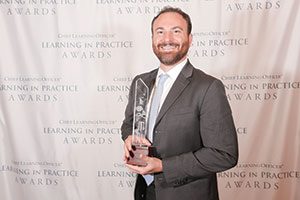Learning in Practice Awards 2016
For learning executives who have either launched a new enterprise learning function or completely overhauled existing workforce development initiatives in the past year.
DIVISION 1
 Liz Huckerby, Chief, Integrated Talent Management, United Nations Development Programme
Liz Huckerby, Chief, Integrated Talent Management, United Nations Development Programme
A new strategic plan at the United Nations Development Programme made the organization’s mission clear: It would eradicate extreme poverty, reduce inequalities and ensure sustainable economic and social development globally. These lofty goals called for agile leadership, which meant a new leadership development program that would span countries, languages and management expertise was necessary.

To start, the Talent Development Unit at UNDP sought insights from the people their program would serve. The team collected feedback from a focus group and an annual survey, and learned that managers felt they lacked the time and support to develop themselves as leaders.
This insight led to the Leadership Development Pathway, which helps more than 500 mid to senior-level managers in 103 UNDP offices. The online program is offered in English, French and Spanish. It starts with a series of self-assessments, and uses a blended learning approach featuring structured content, virtual collaboration and on-the-job projects for practice. Learners also receive professional coaching, mentorship pairings and attend regular webinars.
The UNDP partnered with Acumen to customize a version of the nonprofit’s Human-Centered Design Kit course for LDP use. Challenges led 60 teams of UNDP learners to design solutions to business problems the organization faces, resulting in 120 prototypes that will be shared in an open, global archive.
Since LDP began, managers have participated in more than 1,000 hours of professional coaching. The program’s yearlong commitment means learners have time to develop leadership habits that should continue after the program ends.
—Lauren Dixon
 Michele Parks, Vice President, Talent Management, Cox Communications
Michele Parks, Vice President, Talent Management, Cox Communications
When Cox Communications transformed from decentralized units to centralized Centers of Excellence, Michele Parks, vice president of talent management, knew her department would need to be ahead of the change. If not, the company’s service delivery model could be compromised.
To create a more centralized learning model that meets 21st-century learner needs, Parks met with each functional business executive and team to share her proposal, get feedback and refine the strategic vision. Staffing models changed, as did job descriptions and an analysis of technology needed to support the new design.
At the end of 2015 — the first year of changes — Parks reported reaching 19,115 learners, reducing instructor-led training by 14.4 percent and increasing virtual instructor-led training by 17.6 percent. A new mandatory online course decreased training time by 33 percent, saving 1,500 labor hours.
—Lauren Dixon
James Woolsey, President, Defense Acquisition University
Jim Woolsey, president of the Defense Acquisition University, led the quick execution and implementation of a new College of Contract Management at the Defense Contract Management Agency. He secured funding for college course development, which now has 26 courses, including 11 nominated to the American Council on Education for college credit.
—Lauren Dixon
 Michelle Braden, Vice President, Global Learning Excellence, TELUS International
Michelle Braden, Vice President, Global Learning Excellence, TELUS International
In 2015, TELUS International launched a new leadership development program called Learning@TI roadmap, which outlines learning opportunities for all of its 22,000 employees. The program uses formal, informal and social learning to develop leadership skills and provide consistent onboarding. Also in 2015, employee engagement scores rose 4 percentage points, and attrition fell 9 percent.
—Lauren Dixon
DIVISION 2
 Kenneth Blank, Director, Sales Learning and Development, Paycor Inc.
Kenneth Blank, Director, Sales Learning and Development, Paycor Inc.
To improve education for sales staff and to decrease attrition, Paycor Inc. hired Ken Blank as its sales learning and development leader in October 2014.
His expertise in adult learning and instructional design led him to an “it takes a village” mindset, with responsibilities shared between learners and their managers. He also developed a structured onboarding program that tightened the previous six-month program to five weeks. His focus on keeping things simple meant learning content had to be intuitive to find, simple to understand and easy to implement.
The resulting mobile app, which delivers microlearning to sales staff, along with a social learning platform and a new LMS, helped to create a learning culture. A weekly message helps managers share key information with their staff. This leads to better-informed field sales managers and a more connected chain of information.
Prior to Blank’s hire, Paycor lost 24 out of 72 new sales executives in less than six months. Post new initiative launch, they lost only two out of 64 new sales associates, and growth rates for the 2016 fiscal year are expected to reach nearly 30 percent.
—Lauren Dixon
 Jessica Williams, Former Learning and Development Manager, King’s Hawaiian Holding Co.
Jessica Williams, Former Learning and Development Manager, King’s Hawaiian Holding Co.
King’s Hawaiian grew 400 percent in the past four years, so a consistent, agile training program became necessary for continued success. Due to growing millennial workforce, the company decided to invest in an online learning management system, which would be attractive to that generation and allow all employees to receive the same learning messages.
For soft skills, the company chose off-the-shelf content, while industry and company-specific information required custom content. Training focused on the company’s 13 Keys to Success, created to help maintain a consistent culture at all King’s Hawaiian locations and improve employee engagement.
To help engage learners, the program’s launch featured a Star Wars theme, complete with internally circulated commercials and email communication. A competition challenged employees to complete training quickly, with a reward for the first person to finish. Learner logins rose from less than 30 percent to 68 percent.
—Lauren Dixon














